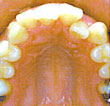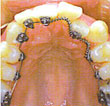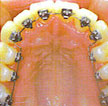Lingual Braces
Lingual braces are attached to the inside or lingual side of the teeth to allow tooth movements to be carried out while making them completely non-visible. This advanced method makes lingual orthodontics particularly well-suited for adults and especially appealing for adults whose professions keep them in the public eyes. No one can tell they are wearing these braces. Patients can enjoy the process of orthodontia while still retaining a natural smile.
Lingual braces are made up of two main components: the small metal pieces (known as brackets) attached directly to the teeth, and the wire which connects them together (known as the arch wire). With standard braces, the brackets are cemented to the front of the teeth, which are quite uniform in their shape. However, lingual brackets are attached to the back side of the teeth.

The back side of each tooth has its own unique shape-unlike the front of each tooth. Each lingual bracket must be custom-formed to the unique shape of each individual tooth. Treatment for lingual braces are usually more difficult than that of standard braces, thus only orthodontists trained in lingual technique are able to offer this form of specialized treatment.
Benefits of Lingual Braces
- Hidden thus not visible that braces are being worn
- Bite opening and better anchorage control
- Less speech hindrance
Although the treatment is more difficult there are lots of techniques being used now which are allowing the lingual orthodontist to treat patients to the same standard as if labial appliances were being used.
Case of Lingual Braces
There are several brands of lingual braces available on the market, older generations of lingual brackets are larger. At BIDC, STb light lingual braces is the norm used by BIDC orthodontist for its lingual orthodontic treatments. The STb light lingual braces uses brackets that are ever smaller and whilst utlizing self-ligating concept.



Procedure of Lingual Braces Treatment
1.First Evaluation and diagnosis
- Medical records are made including a panoramic x-ray and celphlometric x-ray and study model
- An appropriate treatment plan is made based on analysis of the gathered information that is discussed with you
2.Pre-orthodontic treatment
- Any required pre-orthodontic treatment is done such as tooth extraction, gum treatment or teeth scaling
- An teeth impression is then taken for the lingual braces labwork to be made
3.Fitting of braces
- Once the lingual braces labwork is ready, this is fitted onto the lingual side or hidden side of your teet
4.Monthly visits are made to adjust your braces on monthly basis
5.Retainers usually need to be worn during night time after braces are removed
Recovery Expectations
Most people have some discomfort after their braces are first put on or when adjusted during treatment. After the braces are on, teeth may become sore and may be tender to biting pressures for a few days. Patients can usually manage this discomfort well with whatever pain medication they might commonly take for a headache. The orthodontist will advise patients and/or their parents what, if any, pain relievers to take. The lips, cheeks and tongue may also become irritated for one to two weeks as they toughen and become accustomed to the surface of the braces.
Care of Lingual Braces
- Patients with braces must be careful to avoid hard and sticky foods
- Patients must not chew on pens, pencils or fingernails because chewing on hard things can damage the braces. Damaged braces will almost always cause treatment to take longer
- Teeth and braces would need to be kept cleaned every day if the teeth and gums are to be healthy during and after orthodontic treatment
- Follow your orthodontist directions on how often to brush, how often to floss and he use of other cleaning aids to help maintain good dental health





